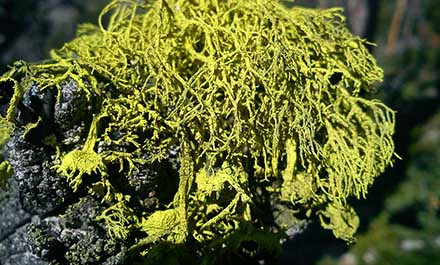- Study
- Student
- Research
- About UNAK
- University
- Schools & faculties
- Governance
- Rector
- Rector’s Office
- University Council
- University Assembly
- University Office
- Laws and regulations
- Organization
- Code of Ethics
- Councils and committees
- Strategies & policies
- On campus
- Human resource
Lichen-associated microbes

About the project
Lichens are defined as the specific symbiotic structure comprising a fungus and a green alga and/or cyanobacterium. Until recently, non-photobiont endothallic bacteria, while known to be present in large numbers, have generally been dismissed as functionally irrelevant cohabitants of the lichen thallus, or even environmental contaminants. Recent analysis of lichen-associated metagenomes and innovative co-culture experiments have however started to lift the veil off a functionally complex community that appears to contribute to a healthy lichen thallus on several fronts. Lichen-associated bacteriomes are typically dominated by several lineages of Proteobacteria, some of which may be lichen species-specific. Recent work has shown members of these lineages to be involved in several important ecophysiological roles. These include nutrient scavenging roles, such as mobilization of iron and phosphate, nitrogen fixation, and lytic activities such as cellulase, xylanase and amylase activity, and oxidation of recalcitrant compounds, such as aromatics and aliphatics. Production of volatile organic compounds, conferring antibacterial and antifungal activity, has also been demonstrated for several lichen-associated isolates.
Members
- Oddur Vilhelmsson, Professor at the School of Business and Science
- Auður Sigurbjörnsdóttir, Adjunct, School of Business and Science
Collaborators
- Ólafur S. Andrésson, Professor, University of Iceland
- Starri Heiðmarsson, Head of Botany, Icelandic Institute of Natural History
- Martin Grube, Professor, Karl-Franzens Universität Graz
- Gabriele Berg, Professor, Graz University of Technology
Publications
- M. Auður Sigurbjörnsdóttir. 2016. The lichen-associated microbiome: Taxonomy and functional roles of lichen-associated bacteria. Ph.D. thesis. University of Iceland.
- Sigurbjörnsdóttir, M. A., and Vilhelmsson, O. (2016) Selective isolation of potentially phosphate-mobilizing, biosurfactant-producing and biodegradative bacteria associated with a sub-Arctic, terricolous lichen, Peltigera membranacea. FEMS Microbiol. Ecol. 92, fiw090. DOI: 10.1093/femsec/fiw090
- Sigurbjörnsdóttir, M. A., Andrésson, Ó. S., and Vilhelmsson, O. (2016) Nutrient scavenging activity and antagonistic factors of non-photobiont lichen-associated bacteria. World J. Microbiol. Biotechnol. 32, 68. doi: 10.1007/s11274-016-2019-2.
- Vilhelmsson, O., Sigurbjörnsdóttir, M. A., Grube, M., and Höfte, M. (2016) Are lichens potential natural reservoirs for plant pathogens? Mol. Plant Pathol. 17, 143-145. DOI: 10.1111/mpp.12344.
- Sigurbjörnsdóttir, M. A., Andrésson, Ó. S., and Vilhelmsson, O. (2015) Analysis of the Peltigera membranacea metagenome indicates that lichen-associated bacteria are involved in phosphate solubilization. Microbiology 161, 989-996. doi: 10.1099/mic.0.000069.
- Sigurbjörnsdóttir, M. A., Heiðmarsson, S., Jónsdóttir, A. R., and Vilhelmsson, O. (2014) Novel bacteria associated with Arctic seashore lichens have potential roles in nutrient scavenging. Can. J. Microbiol. 60, 307-317. doi: 10.1139/cjm-2013-0888.
- Grube, M., Berg, G., Andrésson, Ó. S., Vilhelmsson, O., Dyer, P. S. and Miao, V. (2013) Lichen genomics: prospects and progress. In Ecological Genomics of Fungi (Ed.: Francis Martin), pp. 191-212. Wiley-Blackwell, Oxford, UK. ISBN: 978-1-119-94610-6.
- McCully, L. M., Graslie, J., Bitzer, A. S., Sigurbjörnsdóttir, M. A., Vilhelmsson, O., Silby, M. W. (2021) Exploration of social spreading reveals behavior is prevalent among Pedobacter and P. fluorescens isolates and that there are variations in the induction of the phenotype. Appl. Environ. Microbiol. 87:e01344-21. https://doi.org/10.1128/AEM.01344-21.